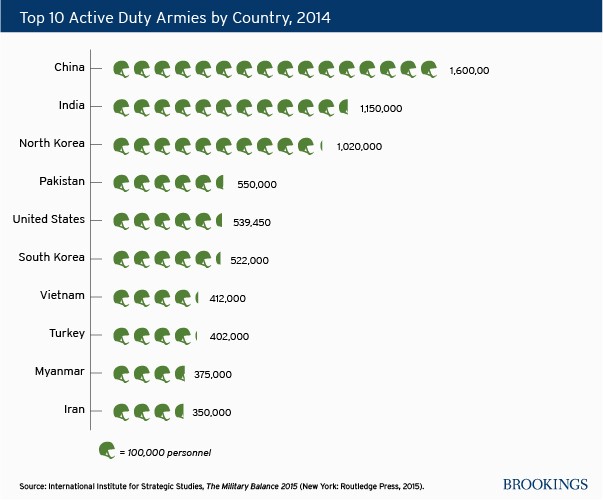How Does The Us Military Compared To Other Countries in terms of size, budget, and capabilities? COMPARE.EDU.VN offers a comprehensive analysis of military strength, expenditure, and technological advancements to provide clarity. Discover key insights into global defense comparisons, military power rankings, and international security dynamics to help you understand the current geopolitical landscape.
1. Understanding US Military Strength: An Overview
The United States military is often perceived as the most powerful in the world. However, a closer examination reveals a more nuanced picture when comparing its strength, budget, and capabilities to those of other nations. This article delves into the key aspects of the US military, offering a comparative analysis against other major global players. We will explore factors such as active personnel, technological advancements, defense spending, and strategic doctrines. Understanding these elements is crucial for grasping the dynamics of international security and the balance of power in the 21st century.
2. Military Expenditure: The US vs. the World
One of the most striking aspects of the US military is its budget. The United States consistently spends more on defense than any other country in the world. According to the Stockholm International Peace Research Institute (SIPRI), US military expenditure in 2022 reached $877 billion, accounting for approximately 39% of total global military spending. This figure surpasses the combined spending of the next nine highest-spending countries.
This immense financial commitment allows the US to maintain a technologically advanced military force, invest in cutting-edge research and development, and project power globally through a network of bases and alliances. However, the sheer size of the budget also raises questions about efficiency and resource allocation, particularly when compared to the military capabilities achieved by other nations with significantly lower expenditures.
3. Active Military Personnel: Size Matters?
While the US boasts the largest defense budget, it does not have the largest active military personnel. As of 2023, the People’s Liberation Army (PLA) of China has the largest active military force in the world, with approximately 2 million personnel. The Indian Armed Forces rank second, with around 1.4 million active personnel, followed by the US military with approximately 1.39 million active personnel.
It’s important to note that the size of a military force is not the sole determinant of its effectiveness. Factors such as training, equipment, leadership, and technological integration play crucial roles. The US military, despite having fewer active personnel than China and India, leverages its technological superiority and advanced training to maintain a competitive edge.
4. Technological Superiority: A Decisive Advantage
The US military has long enjoyed a reputation for technological superiority. This advantage stems from substantial investment in research and development, fostering innovation in areas such as aerospace, cyber warfare, and advanced weaponry. The US military possesses a wide array of sophisticated systems, including:
- Advanced Aircraft: F-35 Lightning II, F-22 Raptor, B-2 Spirit stealth bomber
- Naval Power: Nuclear-powered aircraft carriers, advanced submarines, guided-missile destroyers
- Ground Vehicles: M1 Abrams tanks, advanced armored personnel carriers
- Cyber Warfare Capabilities: Highly sophisticated offensive and defensive cyber capabilities
- Satellite Technology: Extensive satellite network for communication, navigation, and surveillance
This technological edge provides the US military with significant advantages in terms of situational awareness, precision strike capabilities, and overall combat effectiveness. However, other nations are rapidly closing the technological gap, investing heavily in their own defense industries and pursuing advanced technologies.
5. Comparing Military Capabilities: A Country-by-Country Analysis
To gain a deeper understanding of how the US military compares to other countries, let’s examine the capabilities of several key players:
5.1 United States vs. China
China’s military modernization has been remarkable over the past two decades. The PLA has transformed from a largely agrarian force to a modern, technologically advanced military capable of projecting power regionally and increasingly globally. Key areas of comparison include:
| Feature | United States | China |
|---|---|---|
| Military Expenditure | $877 billion (2022) | $292 billion (2022) |
| Active Personnel | 1.39 million | 2 million |
| Naval Power | 11 nuclear-powered aircraft carriers, numerous advanced submarines and destroyers | 3 aircraft carriers, growing fleet of modern destroyers and submarines |
| Air Power | Dominant air force with advanced fighter jets and bombers | Rapidly modernizing air force with advanced fighter jets such as J-20 and stealth drones |
| Cyber Warfare | Highly sophisticated capabilities | Growing cyber warfare capabilities |
| Ballistic Missiles | Advanced ICBMs with multiple independently targetable reentry vehicles (MIRVs) | Extensive arsenal of ballistic missiles, including DF-41 ICBM |


While the US military maintains a technological edge in certain areas, such as naval aviation and cyber warfare, China is rapidly closing the gap. China’s focus on anti-access/area denial (A2/AD) capabilities poses a significant challenge to US power projection in the Indo-Pacific region.
5.2 United States vs. Russia
Russia’s military, while smaller than that of the US, remains a formidable force with extensive experience in conventional and hybrid warfare. Key areas of comparison include:
| Feature | United States | Russia |
|---|---|---|
| Military Expenditure | $877 billion (2022) | $86.4 billion (2022) |
| Active Personnel | 1.39 million | 830,000 |
| Nuclear Arsenal | Large and modern nuclear arsenal | Large and modern nuclear arsenal |
| Ground Forces | Highly mobile and technologically advanced ground forces | Large and well-equipped ground forces with extensive experience in armored warfare |
| Air Power | Dominant air force with advanced fighter jets and bombers | Modern air force with advanced fighter jets such as Su-35 and MiG-31 |
| Cyber Warfare | Highly sophisticated capabilities | Highly sophisticated capabilities |
Russia’s military strengths lie in its nuclear arsenal, extensive experience in ground warfare, and sophisticated cyber capabilities. However, Russia’s defense budget is significantly smaller than that of the US, limiting its ability to invest in cutting-edge technologies and project power globally.
5.3 United States vs. India
India’s military is the third-largest in the world in terms of active personnel. India is rapidly modernizing its armed forces, investing in advanced weaponry and technologies from various countries, including Russia, the United States, and Israel. Key areas of comparison include:
| Feature | United States | India |
|---|---|---|
| Military Expenditure | $877 billion (2022) | $81.4 billion (2022) |
| Active Personnel | 1.39 million | 1.4 million |
| Naval Power | 11 nuclear-powered aircraft carriers, numerous advanced submarines and destroyers | 2 aircraft carriers, growing fleet of destroyers and submarines |
| Air Power | Dominant air force with advanced fighter jets and bombers | Modern air force with a mix of Russian, European, and indigenous fighter jets |
| Nuclear Arsenal | Large and modern nuclear arsenal | Developing nuclear arsenal |
India’s military strengths lie in its large active personnel, growing economy, and strategic location. However, India’s defense industry is still developing, and it relies heavily on foreign arms imports.
5.4 United States vs. Other Nations
Beyond these major players, other countries possess significant military capabilities. For instance:
- United Kingdom: The UK maintains a highly professional and technologically advanced military, focusing on expeditionary warfare and maritime power projection.
- France: France possesses a modern military with nuclear capabilities, focusing on European security and intervention operations in Africa.
- Japan: Japan’s Self-Defense Forces are highly capable and technologically advanced, focusing on defending Japan’s territory and maritime interests.
- South Korea: South Korea maintains a large and well-equipped military, focused on deterring North Korean aggression.
These nations, while not possessing the same scale of military power as the US, China, or Russia, play important roles in regional security and contribute to the global balance of power.
6. Strategic Doctrines and Alliances
Military strength is not solely determined by budget, personnel, and technology. Strategic doctrines and alliances play crucial roles in shaping military capabilities and projecting power.
The United States relies on a network of alliances, including NATO, alliances with Japan and South Korea, and partnerships with countries around the world. These alliances provide the US with access to bases, intelligence sharing, and coordinated military operations.
China’s strategic doctrine emphasizes regional dominance and the protection of its territorial claims in the South China Sea. Russia’s strategic doctrine focuses on maintaining a sphere of influence in its near abroad and deterring NATO expansion.
7. The Future of Military Power
The future of military power will likely be shaped by several key trends:
- Technological Innovation: Artificial intelligence, robotics, hypersonics, and quantum computing are transforming warfare, creating new opportunities and challenges for military planners.
- Cyber Warfare: Cyberattacks are becoming increasingly prevalent, posing a significant threat to military and civilian infrastructure.
- Hybrid Warfare: Hybrid warfare tactics, combining conventional and unconventional methods, are being used to undermine adversaries and achieve strategic objectives.
- Space-Based Capabilities: Space-based assets are becoming increasingly important for communication, navigation, and surveillance, making them attractive targets in future conflicts.
Nations that can successfully adapt to these trends will be best positioned to maintain their military edge in the 21st century.
8. Factors Affecting Military Comparisons
When comparing the US military to other countries, it’s crucial to consider several factors that can influence the assessment:
- Purchasing Power Parity (PPP): Comparing military expenditures based on PPP can provide a more accurate picture of the actual resources available to each country.
- Operational Tempo: The operational tempo of a military, or the frequency and intensity of its deployments and exercises, can affect its readiness and sustainability.
- Training and Experience: The quality of training and the experience of military personnel can significantly impact their effectiveness in combat.
- Logistical Capabilities: Logistical capabilities, including the ability to transport troops and equipment to distant locations, are crucial for power projection.
- Morale and Leadership: Morale and leadership are essential for maintaining unit cohesion and effectiveness in combat.
9. The Role of Non-State Actors
In addition to comparing national militaries, it’s important to acknowledge the growing role of non-state actors in modern warfare. Terrorist groups, insurgent movements, and private military companies can pose significant challenges to national security.
The US military has been heavily involved in counterterrorism operations for the past two decades, and it continues to face threats from non-state actors in various regions around the world.
10. Conclusion: Assessing the US Military’s Standing
The US military remains a dominant force in the world, possessing a large budget, advanced technology, and a global network of alliances. However, other nations are rapidly modernizing their armed forces and closing the technological gap.
China’s military modernization poses a significant challenge to US power projection in the Indo-Pacific region. Russia’s military, while smaller than that of the US, remains a formidable force with extensive experience in conventional and hybrid warfare.
The future of military power will be shaped by technological innovation, cyber warfare, hybrid warfare, and space-based capabilities. Nations that can successfully adapt to these trends will be best positioned to maintain their military edge in the 21st century.
Comparing military capabilities is a complex undertaking, requiring consideration of a wide range of factors, including budget, personnel, technology, strategic doctrines, and alliances. A comprehensive assessment of these factors is essential for understanding the dynamics of international security and the balance of power in the 21st century.
11. Frequently Asked Questions (FAQ)
11.1 How does the US military compare to China’s military?
The US military has a larger budget and technological advantage in some areas, but China has a larger active military force and is rapidly modernizing its military.
11.2 How does the US military compare to Russia’s military?
The US military has a much larger budget than Russia, but Russia has a large and modern nuclear arsenal and extensive experience in ground warfare.
11.3 How does the US military compare to India’s military?
India has the third-largest active military force in the world, but its defense industry is still developing, and it relies heavily on foreign arms imports.
11.4 What are the key strengths of the US military?
The key strengths of the US military include its large budget, advanced technology, global network of alliances, and highly professional personnel.
11.5 What are the key weaknesses of the US military?
The key weaknesses of the US military include its high cost, reliance on complex technology, and challenges in adapting to new forms of warfare.
11.6 How is technology changing the nature of warfare?
Technology is transforming warfare through artificial intelligence, robotics, hypersonics, cyber warfare, and space-based capabilities.
11.7 What is hybrid warfare?
Hybrid warfare combines conventional and unconventional methods to undermine adversaries and achieve strategic objectives.
11.8 What is the role of non-state actors in modern warfare?
Non-state actors, such as terrorist groups and insurgent movements, can pose significant challenges to national security.
11.9 What are the implications of the US military’s global presence?
The US military’s global presence allows it to project power around the world, but it also creates potential for conflict and resentment.
11.10 How can I learn more about military comparisons?
You can learn more about military comparisons by visiting websites such as SIPRI, IISS, and GlobalFirepower, as well as COMPARE.EDU.VN.
12. Making Informed Decisions with COMPARE.EDU.VN
Understanding how the US military compares to other countries is crucial for informed discussions about national security, defense policy, and international relations. At COMPARE.EDU.VN, we strive to provide comprehensive and objective comparisons to help you make well-informed decisions. We understand the challenges in comparing complex entities and aim to provide clear, concise, and data-driven analyses. Our platform is designed to address the difficulties customers face when trying to compare various options, offering detailed insights, unbiased evaluations, and user-friendly formats.
We recognize that customers often struggle with:
- Objectively comparing different options
- Accessing detailed and reliable information
- Dealing with information overload
- Finding visual and easy-to-understand comparisons
- Gaining insights from experienced users
COMPARE.EDU.VN addresses these challenges by offering:
- Detailed and objective comparisons of products, services, and ideas
- Clear listings of pros and cons for each option
- Comparisons of features, specifications, and prices
- User reviews and expert opinions
- Tools to help users identify the best choice based on their needs and budget
Ready to make smarter decisions? Visit COMPARE.EDU.VN today to explore our in-depth comparisons and discover the information you need to make the right choice. Whether you’re comparing technological advancements, military budgets, or strategic doctrines, we provide the insights necessary for a comprehensive understanding.
Contact Information:
Address: 333 Comparison Plaza, Choice City, CA 90210, United States
Whatsapp: +1 (626) 555-9090
Website: compare.edu.vn
This information aims to provide a balanced and objective overview, enabling readers to form their own informed opinions on this critical topic.
